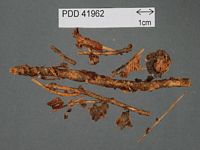|
 Marasmius subsupinus Marasmius subsupinus
SynonymsMarasmius inversus
Agaricus subsupinus
BiostatusPresent in region - Indigenous. Non endemic
Images (click to enlarge)
Caption: 155-Marasmius inversus: a. spores. | 
Caption: Dried type specimen
Owner: Herb PDD |
Article: Massee, G.E. (1899) [1898]. The fungus flora of New Zealand. Transactions and Proceedings of the New Zealand Institute 31: 282–349 Wellington:.
Description: Gregarious or scattered. Pileus membranaceous, dry, reniform or almost circular, brownish or
dingy-ochraceous, almost even and glabrous, usually inverted, so that the gills are uppermost
and the pileus in contact with the substratum 3-6 mm. across ; gills adnate, distant, rather
broad, sometimes forked, shorter intermediate ones present, scarcely or not at all connected
by veins, pale yellowish-buff when dry; spores elliptical, 6-7 x 4 µ; stem lateral or nearly so,
short, slender, coloured like the pileus, arched and standing above the pileus when the latter is
inverted.
Habitat: On slender branches and twigs, lying on the ground.
Distribution: New Zealand.
Notes: A minute but very interesting species, sent to Kew by Colenso (no. b, 563), and was at the
time referred to Marasmius spaniophyllus, Berk., from which species it is indeedtruly
distinct. The last-named species must therefore be removed from the list of New Zealand
Fungi. Readily distinguished by its small size and peculiar inverted habit of growth.
Article: Horak, E. (1971). A contribution towards the revision of the Agaricales (Fungi) from New Zealand. New Zealand Journal of Botany 9(3): 403-462 (http://www.rsnz.org/publish/abstracts.php).
Notes: Fig. 13 The type collection (COLENSO b 563) consists of fruiting bodies up to 1
cm in diam. with an often excentrically inserted stipe, growing on rotten wood.
Spores slightly amygdaliform or comma-like, neither amyloid nor dextrinoid,
smooth, 7.5-9.5 X 4-5 µ. According to our knowledge M. inversus is a good
species of Marasmius sensu lato.
Article: Stevenson, G. (1964). The Agaricales of New Zealand: V. Kew Bulletin 19(1): 1-59.
Description: The type specimen at Kew has been examined and the following; description applies to it:
Pileus 5-10 mm diam., pinkish sepia, furfuraceous, orbicular to reniform. Gills adnate pinkish fawn, moderately distant. Stipe 2-3 x 0.5 mm, pinkish sepia, farinaceous, excentric, curved, inserted in dead wood. Spores 8-10 x 4-5 µm, non-amyloid. Hymenophoral trama non-amyloid. Cuticle of pseudoamyloid globe cells.
The New Zealand material referred to this species by Massee (1898), and preserved at Kew, is not of Marasmius but appears to belong to the Laschia complex. Massee's statement that the gills are sometimes uppermost is incorrect. The writer has no herbarium specimens of M. subsupinus, but considers that a small stalked bracket agaric, commonly seen on standing dead wood in New Zealand, is referable to this species. More collections are needed.
M. inversus Massee in Trans. N.Z. Inst. 31: 343 (1898) appears to be identical, though the spores of the type, which has been examined at Kew slightly smaller, 6-8 x 4-5 µm Massee's claim that the gills are uppermost appears insupportable, and may have been due to a lack of understanding of the habit of growth.
|